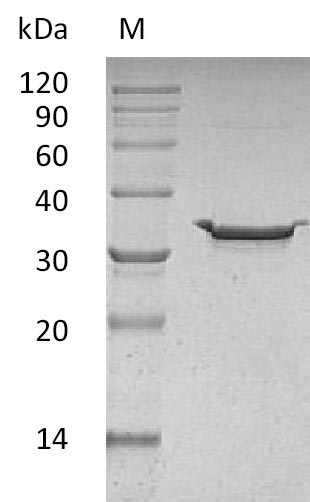Recombinant Human Carbonic anhydrase 5B, mitochondrial (CA5B) is produced in E. coli and contains the complete mature protein sequence from amino acids 34-317. The protein carries a C-terminal 6xHis tag, which makes purification and detection more straightforward. SDS-PAGE analysis confirms purity levels exceeding 95%, while endotoxin content remains below 1.0 EU/μg as determined by the LAL method. The protein shows biological activity with esterase activity measuring 233 pmol/min/μg.
Carbonic anhydrase 5B (CA5B) functions as a mitochondrial enzyme that catalyzes the reversible hydration of carbon dioxide. This enzyme belongs to the carbonic anhydrase family, participating in several physiological processes including pH regulation and ion transport. CA5B appears to play a significant role in metabolic pathways by helping maintain acid-base homeostasis, which has made it an important target for biochemical research.
Potential Applications
Note: The applications listed below are based on what we know about this protein's biological functions, published research, and experience from experts in the field. However, we haven't fully tested all of these applications ourselves yet. We'd recommend running some preliminary tests first to make sure they work for your specific research goals.
1. Carbonic Anhydrase Enzyme Kinetics and Inhibitor Screening
This recombinant CA5B is confirmed to have esterase activity (233 pmol/min/μg) and is suitable for enzyme kinetics and inhibitor screening. However, researchers should note that esterase activity is a surrogate assay and may not fully replicate physiological CO2 hydration kinetics. The C-terminal His-tag may slightly alter enzyme properties or substrate access, so kinetic parameters should be validated with tag-free CA5B or natural substrates when possible. The high purity (>95%) and low endotoxin support reliable assays, but results should be corroborated with mitochondrial extracts or full physiological assays for biological relevance.
2. Antibody Development and Validation
This full-length mature CA5B (34-317aa) serves as a good antigen for antibody development. However, the C-terminal His-tag may induce tag-specific antibodies, reducing antibodies against CA5B-specific epitopes. Comprehensive validation should include testing against native, mitochondrial-derived CA5B to ensure recognition of physiologically relevant forms. The E. coli expression produces a non-glycosylated protein, but CA5B is not glycosylated, minimizing concerns; still, antibody specificity should be confirmed in cellular contexts.
3. Protein-Protein Interaction Studies
The His-tagged CA5B can be used for pull-down assays, but CA5B is primarily a metabolic enzyme with limited known protein-protein interactions beyond its catalytic role. Identified interactors should be validated in mitochondrial systems to ensure biological relevance, as CA5B functions in mitochondria. The tag may cause non-specific binding, so rigorous controls (e.g., tag-only) are essential. Interactions with mitochondrial proteins or regulatory factors are more plausible than broad interactome screens.
4. Structural and Biophysical Characterization
The high-purity CA5B is suitable for biophysical studies, but the C-terminal His-tag may impede crystallization and should be removed for high-resolution structural work. E. coli expression produces a non-glycosylated protein, which is acceptable as CA5B lacks glycosylation, but mitochondrial import signals or modifications may be missing. The confirmed activity suggests proper folding, but structural conclusions should be validated with full-length protein, including mitochondrial targeting sequences if relevant.
5. Comparative Enzyme Activity Analysis
The protein enables comparative studies with other CA isoforms or mutants, but researchers should ensure comparisons are made with proteins expressed in identical systems to avoid expression-related artifacts. The esterase activity provides a baseline, but physiological comparisons should include CO2 hydration assays for relevance to mitochondrial function. The His-tag may affect activity, so tag-free controls or isoform-specific tags are recommended for accurate comparisons.
Final Recommendation & Action Plan
This recombinant human CA5B expressed in E. coli with a C-terminal His-tag is a functional tool with confirmed esterase activity, making it suitable for enzyme kinetics, antibody development, and biophysical studies, but researchers must account for its prokaryotic expression and tag. For immediate use, employ it in esterase assays at activities around 233 pmol/min/μg, but validate key kinetic parameters with physiological substrates (e.g., CO2) and tag-free CA5B when possible. When developing antibodies, use this protein for immunization, but screen clones against mitochondrial CA5B to avoid tag-specific responses. For interaction studies, focus on mitochondrial partners and include stringent controls. For structural work, remove the His-tag prior to crystallization. For comparative analyses, use consistently expressed proteins to ensure fair comparisons. Always consider the mitochondrial context of CA5B and validate findings in cellular or organellar models to ensure physiological relevance. The high purity and low endotoxin support reliable in vitro assays, but critical biological insights require confirmation in more complex systems.






